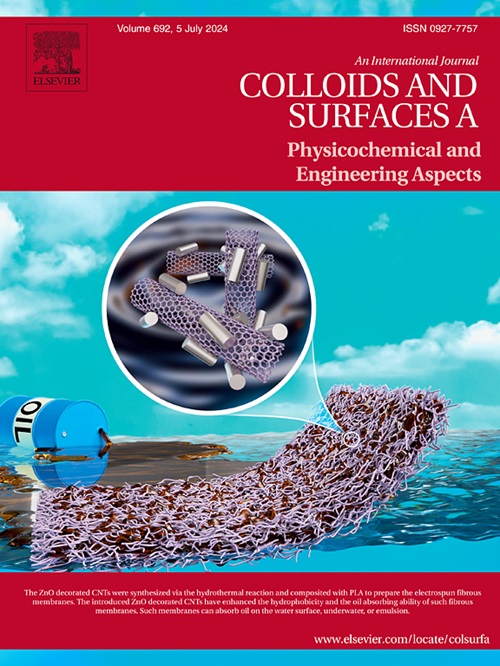通过低聚物引发的界面聚合(OT-IP)制备 COF-LZU1/PVDF 复合松散纳滤膜,实现高效染料/盐分离
IF 4.9
2区 化学
Q2 CHEMISTRY, PHYSICAL
Colloids and Surfaces A: Physicochemical and Engineering Aspects
Pub Date : 2024-11-08
DOI:10.1016/j.colsurfa.2024.135713
引用次数: 0
摘要
共价有机框架(COFs)具有易官能化、丰富的规则孔隙、低密度等优点,被广泛应用于膜材料的制备。本研究通过低聚物引发的界面聚合(OT-IP)技术,在室温下制备了生长良好的COF-LZU1(LZU代表兰州大学)/聚偏氟乙烯(PVDF)疏松纳滤(NF)复合膜。由于其孔径为 1.72 nm,制备的 COF-LZU1/PVDF 膜不仅对染料具有超高的截留率(对甲基蓝的截留率为 99.4%,对刚果红的截留率为 99.7%,对梨色黑 T 的截留率为 99.1%)。此外,CR/NaCl 混合溶液的过滤实验表明,染料/盐的选择性系数为 328.7,渗透率为 77.0 L-m-2-h-1-bar-1,纯水渗透率高达 112.3 L-m-2-h-1-bar-1。连续过滤实验表明,COF-LZU1/PVDF 膜具有出色的运行稳定性。研究结果表明,COF-LZU1/PVDF 膜有望用于分离染料和盐类。本文章由计算机程序翻译,如有差异,请以英文原文为准。
Fabrication of COF-LZU1/PVDF composite loose nanofiltration membranes through oligomer-triggered interfacial polymerization (OT-IP) for highly efficient dye/salt separation
Covalent organic frameworks (COFs) have advantages such as easy functionalization, abundant regular pores, low density, and are widely used in the preparation of membrane materials. In this study, the well-grown COF-LZU1 (LZU for Lanzhou University)/polyvinylidene fluoride (PVDF) loose nanofiltration (NF) composite membranes were prepared through oligomer-triggered interfacial polymerization (OT-IP) at room temperature. Due to its pore size of 1.72 nm, the prepared COF-LZU1/PVDF membrane not only exhibited an ultra-high rejection for dyes (99.4 % for Methyl blue, 99.7 % for Congo red, and 99.1 % for Eriochrome black T). In addition, the filtration experiment of the mixed CR/NaCl solution showed a dye/salt selectivity factor of 328.7, as well as a permeance of 77.0 L·m−2·h−1·bar−1 and a high pure water permeability of 112.3 L·m−2·h−1·bar−1. A continuous filtration experiment showed that the COF-LZU1/PVDF membrane exhibited excellent operational stability. The findings suggest that COF-LZU1/PVDF membrane show promise for use in separating dyes and salts.
求助全文
通过发布文献求助,成功后即可免费获取论文全文。
去求助
来源期刊
CiteScore
8.70
自引率
9.60%
发文量
2421
审稿时长
56 days
期刊介绍:
Colloids and Surfaces A: Physicochemical and Engineering Aspects is an international journal devoted to the science underlying applications of colloids and interfacial phenomena.
The journal aims at publishing high quality research papers featuring new materials or new insights into the role of colloid and interface science in (for example) food, energy, minerals processing, pharmaceuticals or the environment.

 求助内容:
求助内容: 应助结果提醒方式:
应助结果提醒方式:


